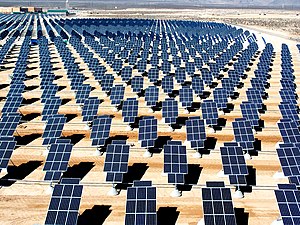Here’s a long story in the Observer about the state of solar energy in Texas. The piece covers a lot of ground, including this bit about what’s going on in San Antonio.
San Antonio has emerged as a city willing to turn talk into action and its abundant sunlight into energy to spark what Mayor Julian Castro—the one who the New York Times Magazine suggested could be America’s first Latino president—calls the “New Energy Economy.” In the era of Solyndra, San Antonio is making a bold, maybe risky bid at deploying solar energy on a scale that could edge the city away from fossil fuels, create jobs and reduce greenhouse gasses, water consumption and air pollution. Castro and the city’s massive utility, CPS Energy, are betting that climate change, depleting fossil fuels and increased drought stress will make early investments in renewable energy and clean technologies a huge payoff in the future.
In San Antonio, things have unfolded rapidly. In 2010, CPS Energy pledged to have 20 percent of its generating capacity, about 1,500 megawatts, come from renewables and 65 percent of its portfolio be low-carbon. The utility set a goal of 100 megawatts for solar. That same year, the 14-megawatt Blue Wing, San Antonio’s first utility-scale solar farm, went online. At the time, it was the largest photovoltaic array—a system that converts sunlight directly into electricity—in Texas and the third-largest in the nation. Then in October 2010, CPS contracted with SunEdison, a Maryland-based solar developer, to build and run three more 10-megawatt solar farms around the city. Almost as soon as that deal was in place, the utility rolled out a solicitation for another 50 megawatts, nearly bringing CPS to its 100 megawatt solar goal. But there was a big twist this time: The bidders would have to bring a manufacturing proposal to the table and put down roots in San Antonio. Clean energy alone wasn’t enough; San Antonio wanted to build a clean energy economy.
In June 2011, amid a record heat wave and drought, Castro and CPS head Doyle Beneby called together the business, environmental and political community for some big news. Five clean technology companies were opening offices or relocating to San Antonio, bringing about 230 jobs to the city as well as agreements to pump money and research into the University of Texas at San Antonio’s Sustainable Energy Research Institute.
“San Antonio has the opportunity to seize a mantle that no city in the U.S. holds today: to be the recognized leader in clean energy technology,” Castro said in announcing the relocations.
But what electrified the solar industry was when CPS Energy, in July, abruptly increased its solicitation for a 50-megawatt solar plant to 400 megawatts, enough to power 80,000 homes. The response to the 50-megawatt proposal was so positive and the offers so low that CPS simply couldn’t pass up the opportunity to do something really big. “The price was just rock-bottom on the delivered power,” said Lanny Sinkin.
By the time the bidding closed in July, the utility had received over 30 proposals. But after the deadline, with solar costs dropping practically overnight, new intriguing offers kept rolling in. Tantalized, the CPS board voted unanimously in October to reopen the bidding, this time with stricter requirements. Bidders had to provide a plan not just for building 400 megawatts of photovoltaic solar but also for bringing a manufacturing facility to San Antonio, along with at least 800 jobs and a capital investment of $100 million.
See here and here for more, and be sure to read the whole story in the Observer as well. The story briefly mentions rooftop solar panels and some of the ways that they can be financed, but there’s still one option on the table that no one seems to be using yet. Be that as it may, this story came out at the same time as an announcement from Houston about a federal grant to help make solar panel installs more affordable. Not a huge grant – less than $100K – but every little bit helps. More big thinking like they’re doing in San Antonio would help even more.

